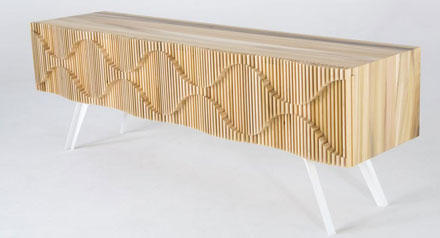
The American Hardwood Export Council (AHEC) and eight of Australia’s most highly regarded designers collaborated to reimagine their works in American tulipwood. Source: Timberbiz
Anne-Claire Petre, Adam Goodrum, Adam Markowitz, Coco Reynolds, Dowel Jones, Jon Goulder, Ross Gardam and Tom Skeehan rose to the challenge.
AHEC asked them to consider replacing the timber they normally use for their signature designs with American tulipwood.
Tulipwood has been favoured in Europe for generations, but is little known in Australia. One of the most beautiful and easily worked hardwoods from the United States. Light, straight grained and even textured, its colour ranges from blond to brown and even to green and purple in places.
Encouraged to embrace the natural variation in the material provided, the designers confronted the Australian preference for uniformity in timber.
Adam Goodrum chose to recreate his iconic Molloy chair, a solid timber piece composed of 8 elements that seamlessly jigsaw together.
“The Molloy chair components are accentuated by the contrasting grain directions where they meet to become one” he says of the design. “The colour variation in tulipwood gives a further opportunity to emphasise the different elements in the design.”
Ross Gardam similarly found the replacement of the American oak of his classic ‘Oak Pendant’ with tulipwood emphasised joins in the design which were secondary in the original product. The result is a visually more striking piece.
John Goulder’s Glissando Credenza, which is on permanent show in the National Gallery of Australia in American walnut, has taken on a “whole new look and meaning” in tulipwood, claims it creator, and become a “capsule of environmentally responsible furniture production and philosophy”.
The American hardwood forest has been sustainably managed for generations. Each year trees are selectively harvested and replaced by new growth through natural generation.
American tulipwood is one of the most prolific hardwoods. Growth exceeds harvest in all US states and net volume (after harvest) is increasing by 19.7 million cubic metres each year.
Evostyle, who manufactured all the designs for ‘Replaced’ meticulously recorded all timber used, energy inputs and waste produced. By working with the natural colour of the tulipwood and using it to enhance their designs, wastage has been kept to a minimum. The species is also light to export from the US to Australian shores.
This data has enabled the American Hardwood Export Council to measure the precise environmental impact of each and every design in the collection. By applying a scientific method to measuring environmental impact, in addition to the United States’ proven and documented record of sustainability in hardwood production, the designers involved in the project have been able to fulfill their desire to work sustainably and with a minimal environmental impact. Initial calculations show that the tulipwood used to create all the designs in the collection would be replaced in the US forest in just over 1 second. Furthermore, the designs would produce the same carbon footprint in their entire lifetime as the average Australian would produce in less than 9 days.
Anne-Claire Petre who has reimagined her popular Emi pod for the collaboration says: “In a world where throwaway culture has become predominant, it is of utmost importance to have an environmental approach to design and manufacture. It is a lifestyle choice that extends from my personal life and attitude to waste, into my business and my work. It is our role as designers to educate the public about better design and sustainability and emphasise why it is critical to our economy, to our planet and to people. Using sustainable timbers in furniture is the least we can do”.
Rod Wiles, Regional Director of AHEC agrees: “The main responsibility of a designer is surely to make create a living environment in which we can feel comfortable, feel happy and are able to thrive. Making the world a more beautiful place should however never come at the cost of the world itself”.
The Replaced collection was shown at Denfair in Melbourne in June.





